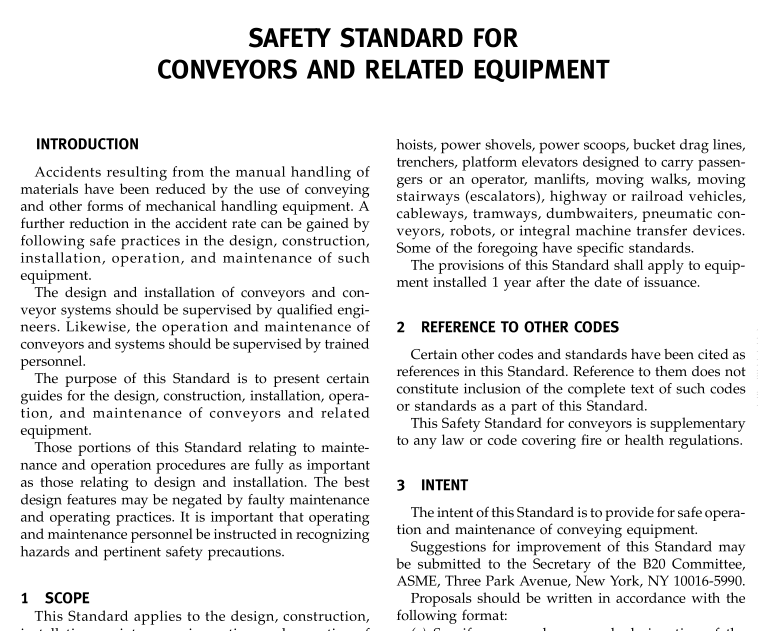ASME B20.1-2006 pdf download

ASME B20.1-2006 pdf download Safety Standard for Conveyors and Related Equipment
5.4 Adjustment or Maintenance During Operation When adjustment or maintenance must be done while equipment is in operation, only trained and qualified personnel who are aware of the hazard of the conveyor in motion shall be allowed to make adjustment or perform the maintenance or service.
5.5 Backstops and Breaks Antirunaway, brake, or backstop devices shall be pro- vided onallincline, decline, orvertical conveyors, where the effect of gravity will allow uncontrolled lowering of the load and where this load will cause a hazard to personnel.
5.6 Overload Protection Where overload conditions would cause damage to equipment that could result in a personal injury, overload devices or suitable warning means shall be pro- vided.
5.7 Gates and Switches
(a) Power-positioned gate and switch sections shall be provided with devices that will prevent these sections from falling in case of power failure.
(b) Means shall be provided on all gate and switch sections to prevent conveyed material from discharging into theopenarea, created byliftingofthe gate orswitch. 5.8 Counterweights When counterweights are supported by belts, cables, chains, and similar means, weights shall be confined in an enclosure to prevent the presence of personnel beneath the counterweight. As an alternative, the arrangement shall provide a means to restrain the falling weight in case of failure of the normal counterweight support.
5.9 Guards and Guarding
5.9.1 General Requirements of Guarding
5.9.1.1 Guarding. Where necessary for the protec- tion of personnel from hazards, all exposed moving machinery parts that present a hazard to personnel at workstations or operators’ stations shall be mechani- cally or electrically guarded or guarded by location or position.
5.9.1.2 Interfacing of Equipment. When two or more pieces of equipment are interfaced, special atten- tion shall be given to the interfaced area to ensure the presence of adequate guarding and safety devices.
5.9.1.3 Guarding Exceptions. Wherever condi- tions prevail that would require guarding under this Standard but such guarding would render the conveyor unusable, prominent warning means, such as signs or warning lights, shall be provided in the area or on the equipment in lieu of guarding.
5.9.1.4 Maintenance of Guards and Safety Devices. Guards and safety devices shall be maintained in a serviceable and operational condition. Warning signs provided in accordance with para.
5.9.1.3 shall be maintained in a legible/operational condition.
5.9.2 Guarding by Location or Position
(a) Remoteness from frequent presence of public or employed personnel shall constitute guarding by location. (b) Overhead conveyors, such as trolley conveyors and hanger-suspended tray conveyors, for which guard- ing would render the conveyor unusable or would be impracticable, shall have prominent and legible warn- ings posted in the area or on the equipment, and, where feasible, lines shall be painted on the floor delineating the danger area.
(c) When a conveyor passes over a walkway, roadway, or workstation, it is considered guarded by location if all moving parts are at least 2.44 m (8 ft) above the floor or walking surface or are otherwise located so that personnel cannot inadvertently come in contact with hazardous moving parts.
(d) Although overhead conveyors may be guarded by location, spill guards, pan guards, or equivalent shall be provided if material may fall off the conveyor and endanger personnel.
5.9.3 Guarding of Nip and Shear Points. In general, nip and shear points shall be guarded unless other means to ensure safety are provided. See Section 6 for specific conveyors.
5.10 Headroom
(a) When conveyors are installed above exit passage- ways, aisles, or corridors, there shall be provided a mini- mum clearance of 2 m (6 ft 8 in.) measured vertically from the floor or walking surface to the lowest part of the conveyor or guards.
(b) Where system function will be impaired by pro- viding the minimum clearance of 2 m (6 ft 8 in.) through an emergency exit, alternate passageways shall be pro- vided.
(c) It is permissible to allow passage under conveyors with less than 2 m (6 ft 8 in.) clearance from the floor for other than emergency exits if a suitable warning indicates low headroom.









